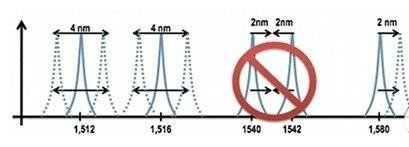What is the working principle of fiber Bragg grating sensor?
Inquiry method
Because fiber Bragg gratings can be implanted with different specific reflection wavelengths, it can be used to achieve good wavelength division multiplexing (WDM) technology. This feature makes it possible to connect multiple different sensors with specific Bragg wavelengths in the form of a daisy chain on a long independent fiber. Wavelength division multiplexing technology assigns each FBG sensor a specific wavelength range for its use in the broad optical spectrum available. Due to the inherent wavelength characteristics of the fiber Bragg grating, even if the optical fiber medium is bent and transmitted during the transmission process to cause loss and attenuation of the light intensity, the results measured by the sensor can still be kept accurate.
The working wavelength range of each individual fiber Bragg grating sensor and the total wavelength range that the wavelength interrogator can interrogate determine the number of sensors that can be attached to a single fiber. Generally speaking, because the wavelength change caused by the strain change is more obvious than the wavelength change caused by the temperature change, the FBG strain sensor is generally assigned an operating wavelength range of about 5 nanometers, and the FBG temperature sensor is assigned an operating wavelength of about 1 nanometer range. And because the typical wavelength interrogator can provide a test range of about 60 to 80 nanometers, the number of sensors attached to a fiber can generally range from 1 to 80-of course, this must be based on the reflection wavelength of each sensor The regions will not overlap on the basis of the spectral range (picture). Therefore, when selecting an FBG sensor, it is necessary to carefully select the nominal wavelength and operating wavelength range to ensure that each sensor has its own independent operating wavelength region.

Figure. Each FBG sensor attached to the same fiber must have its own independent operating wavelength range
A typical FBG sensor will have an operating wavelength range of a few nanometers, so the optical interrogator must be able to perform measurements with a resolution of a few picometers or less – a fairly small order of magnitude. There are several ways to interrogate FBG grating sensors. Interferometers are commonly used laboratory equipment, which can provide fairly high-resolution spectral analysis. However, these instruments are generally very expensive, bulky and not strong enough, so in some applications involving on-site monitoring of various structures, such as fan blades, bridges, water pipes and dams, these instruments are not Be applicable.
A more robust method is to introduce a charge-coupled device (CCD) and a fixed decentralized unit, generally referred to as wavelength position conversion.
In this method, a broad-spectrum light source is used to illuminate the FBG sensor (or a series of FBG sensors). These reflected beams will pass through a dispersive unit, which will distribute the reflected beams with different wavelengths to different positions on the surface of the charge-coupled device (CCD).
This method can quickly and simultaneously measure all FBG sensors attached to the fiber, but it only provides very limited resolution and signal-to-noise ratio (SNR). For example, if we want to achieve a resolution of 1 picometer in the wavelength range of 80 nanometers, then we need a linear CCD device containing 80,000 pixels. This pixel index is already higher than that currently available on the market. The index of the best linear CCD device (as of July 2010) is more than 10 times higher. In addition, because the energy of the broad-spectrum light source is dispersed into a wide wavelength range, the energy of the FBG reflected beam will be very small, and sometimes it will cause difficulties in measurement.
At present, the most popular method is to use a tunable Fabry-Perot filter to create a beam of high-energy, and can quickly sweep the laser source to replace the traditional broad-spectrum light source. The tunable laser source concentrates energy in a very narrow wavelength range, providing a high-energy light source with a high signal-to-noise ratio. The high optical power provided by this architecture makes it possible to use a single fiber to mount multiple optical channels, which can effectively reduce the cost of the multi-channel interrogator and reduce the complexity of the system. The interrogator based on this tunable laser architecture can scan in a relatively large wavelength range with a very narrow spectral band. On the other hand, a photodetector will synchronize with this scan to measure the reflection back from the FBG sensor Laser beam. When the laser wavelength emitted by the tunable laser coincides with the Bragg wavelength of the FBG sensor, the photodetector can measure the corresponding response. When the response occurs, the wavelength of the tunable laser corresponds to the temperature and / or strain measured at the FBG sensor at this time, as shown in Figure 6.
Using this method for interrogation can achieve an accuracy of about 1 picometer, corresponding to the accuracy of traditional FBG sensors is about 1.2 microstrain (FBG strain sensor) or about 0.1 degrees Celsius (FBG temperature sensor). Because the tunable laser source method has a very high optical power compared to other methods, this interrogation method can also be applied to measurement applications where the fiber length is longer (more than 10 kilometers).
If you want to know more, our website has product specifications for sensor, you can go to ALLICDATA ELECTRONICS LIMITED to get more information

